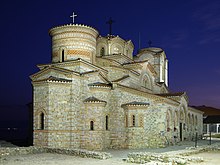Church of Saints Clement and Panteleimon
| Saints Clement and Panteleimon | |
|---|---|
Свети Климент и Пантелејмон Sveti Kliment i Pantelejmon | |
Byzantine style | |
| Capacity | 3,000 |
The Church of Saints Clement and Panteleimon (
History
The original church is believed to have been built when Saint Clement arrived in Ohrid at the request of

Saint Clement used his newly created church as a
still exists today.In the 15th century, Ottoman Turks converted the church into a mosque but during the beginning of the 16th century allowed ruined monasteries and churches to be restored, therefore, so was Saint Clement's church. The church was again ruined during the end of the 16th century or the beginning of the 17th century and another mosque, called Imaret Mosque (Turkish: İmaret Camii), was erected by the Ottomans.[4] The Imaret Mosque was torn down in 2000 with the reason given that it was constructed over the remains of a church in the Plaošnik area and the former mosque was added to the damaged religious buildings list compiled by the Islamic Religious Community of Macedonia.[5]
Architecture

Many archaeologists believe that Clement himself designed and constructed the church. Clement, along with
The church stands on a
The exterior of the church contains a large number of finely detailed mosaics not far from a stone baptismal font used to baptise his disciples.
Reconstruction and excavation
Apart from the church's many reconstructions during the
On October 10, 2007, a collection of approximately 2,383 Venetian coins was discovered by archaeologists while excavating the church. A prominent archaeologist of North Macedonia, Pasko Kuzman, stated that the coins are of special significance because they indicate that Ohrid and Venice were commercially linked.[8]
Tradition
As the church is one of the most sacred in North Macedonia, thousands of
Gallery
-
The bell tower on the side of the church. An icon above the entrance depicts Saint Clement and Saint Panteleimon
-
Archeological excavations at Plaošnik
-
View of the rear side
-
View of the front side
-
Entry
-
The detailed architectural style of the church
-
Baptistry and surrounding mosaic floor of an early Christian basilica
References
- ^ Dvornik, Francis (1956). The Slavs: Their Early History and Civilization. Boston: American Academy of Arts and Sciences. p. 179.
The Psalter and the Book of Prophets were adapted or "modernized" with special regard to their use in Bulgarian churches and it was in this school that the Glagolitic script was replaced by the so-called Cyrillic writing, which was more akin to the Greek uncial, simplified matters considerably and is still used by the Orthodox Slavs.
- ISBN 978-0-521-81539-0.
- ISBN 978-0-19-161488-0.
- ^ "St. Clement's church "St. Pantheleimon"". Archived from the original on 2011-11-06. Retrieved 2017-01-29.
- ISBN 978-9989-58-155-7.
- ^ Father Samuel. "Journey to Macedonia, Part II: St. Clement of Ohrid". Archived from the original on 2012-06-30. Retrieved 2017-01-29.
- ^ "On Plaosnik – a New Building on Ancient Foundations – Saint Clement's Temple Resurrects in the New Age". Nova Makedonija. 2002-04-05. Archived from the original on 2012-06-30. Retrieved 2017-01-29.
- Večer. 2007-10-10. Archived from the originalon 2012-06-30. Retrieved 2017-01-29.







